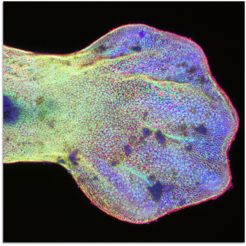Can Aztekin
Structural Regeneration
Friedrich Miescher Laboratory
Faculty: IMPRS

Vita
- PhD at University of Cambridge, Gurdon Institute, Cambridge, UK, 2021
- Independent group leader/ELISIR Scholar, EPFL School of Life Sciences, Lausanne, Switzerland, 2021-current
- Branco Weiss Fellow, 2022-current
Max Planck Research Group Leader at the FML (starting February 2025)
Research Interest
How do some animals, like frog tadpoles or salamanders, regrow their lost limbs while humans cannot?
We are interested in understanding how cellular behaviors drive limb and tail regeneration, which cell type interactions are critical for these processes, and what goes differently in limb regeneration-incompetent mammals. Through our research, we have used single-cell RNA sequencing (scRNA-seq) to map the cellular composition involved in regeneration, revealing the crucial role of specific regenerative epithelial signaling center cell types (Aztekin et al., Science, 2019; Aztekin et al., Development, 2021). Expanding on these findings, we identified similar cell types across different species, including mammals (Zhong et al., Nature Communications, 2023). At the same time, we developed ex vivo, stem cells-based, and organoid models that allow us to examine regeneration and the regenerative cell types in unprecedented detail (Aztekin et al., Development, 2021; Skoufa et al., bioRxiv, 2024).

Leveraging our new models, which offer many new perspectives, in combination with state-of-the-art single-cell -omics and imaging methods, we aim to address fundamental questions that could enable human limb regeneration in the future.
Available PhD Projects
Currently not recruiting PhD students
Selected Reading
- Skoufa, E., Zhong, J., Kahre, O., Hu, K., Tsissios, G., Carrau, L., Herrera, A., Dominguez Mantes, A., Castilla-Ibeas, A., Jang, H., Weigert, M., Manno, G. L., Lutolf, M., Ros, M., & Aztekin, C. (2024). Specialized signaling centers direct cell fate and spatial organization in a limb organoid model. bioRxiv, 2024.07.02.601324. https://doi.org/10.1101/2024.07.02.601324
- Aztekin, C. (2024). Mechanisms of regeneration: To what extent do they recapitulate development? Development, 151(14), dev202541. https://doi.org/10.1242/dev.202541
- Zhong, J., Aires, R., Tsissios, G., Skoufa, E., Brandt, K., Sandoval-Guzmán, T., & Aztekin, C. (2023). Multi-species atlas resolves an axolotl limb development and regeneration paradox. Nature Communications, 14(1), Article 1. https://doi.org/10.1038/s41467-023-41944-w
- Aztekin, C., Hiscock, T. W., Gurdon, J., Jullien, J., Marioni, J., & Simons, B. D. (2021). Secreted inhibitors drive the loss of regeneration competence in Xenopus limbs. Development (Cambridge, England), 148(11), Article 11. https://doi.org/10.1242/dev.199158
- Aztekin, C., Hiscock, T. W., Marioni, J. C., Gurdon, J. B., Simons, B. D., & Jullien, J. (2019). Identification of a regeneration-organizing cell in the Xenopus tail. Science, 364(6441), Article 6441. https://doi.org/10.1126/science.aav9996

